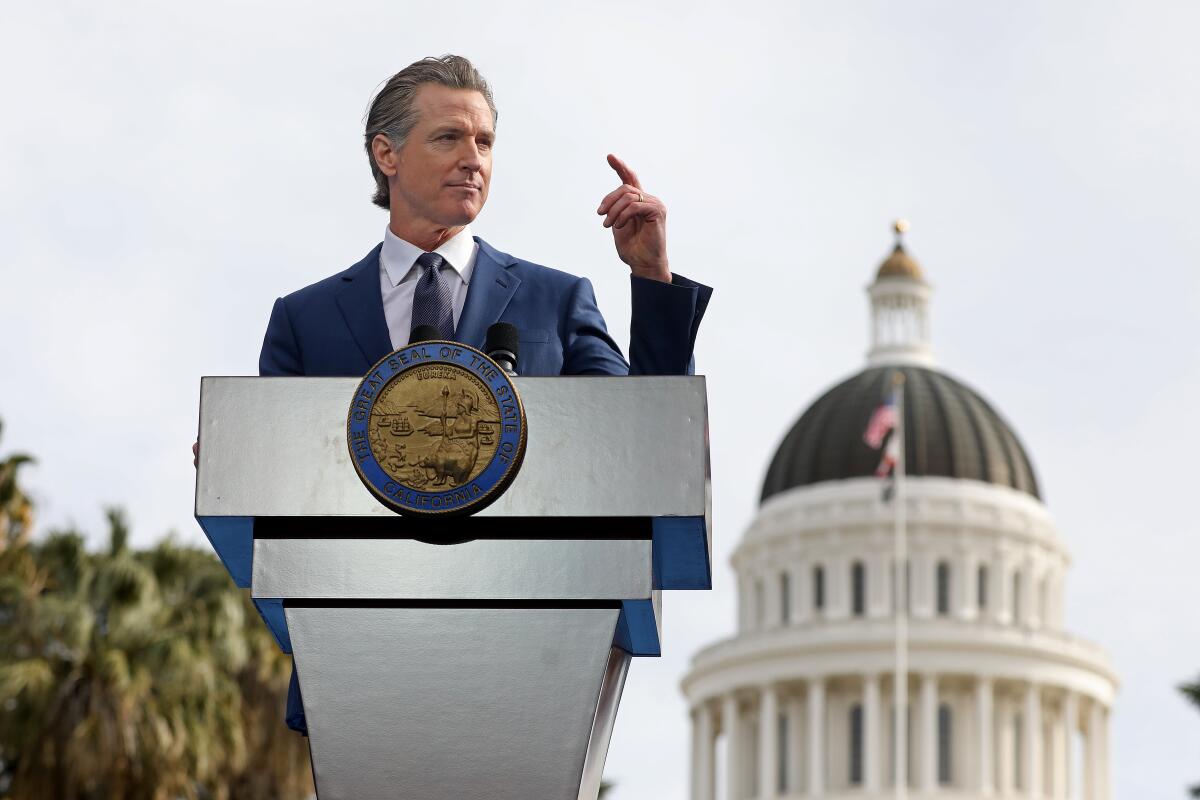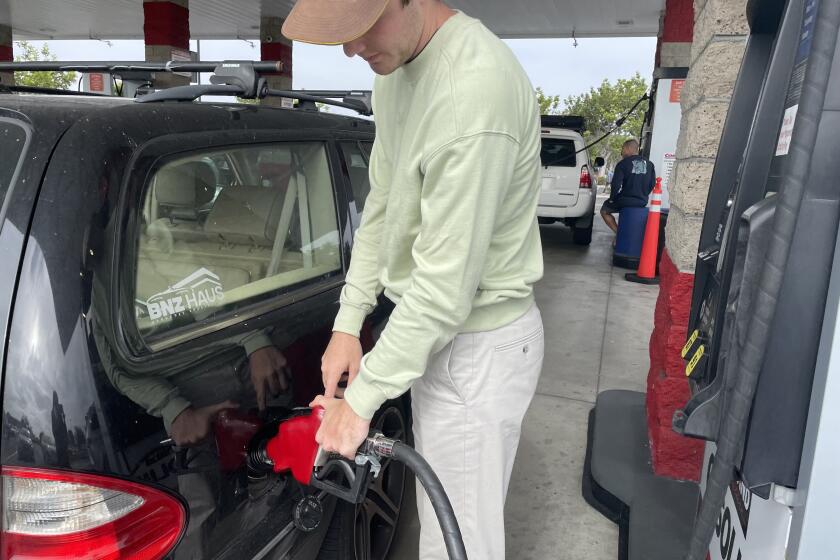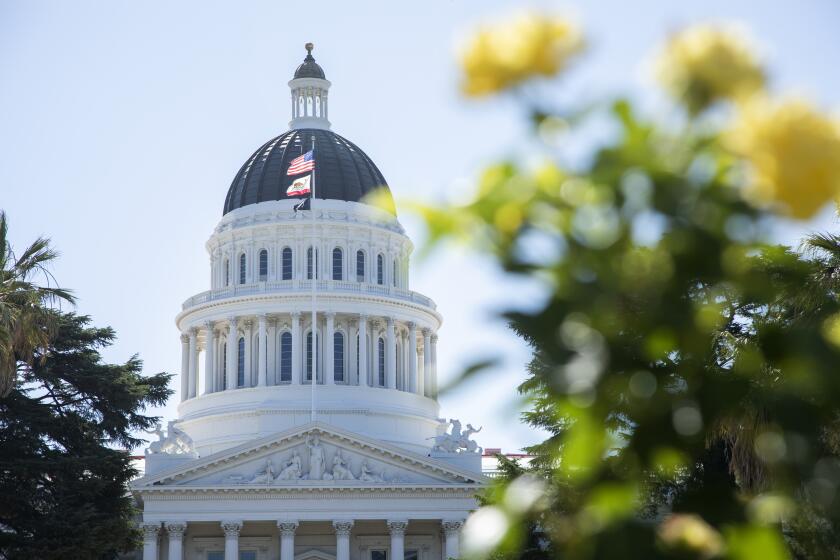Newsom proposes cuts to climate change programs amid cloudy economic outlook

- Share via
SACRAMENTO — Facing a projected $22.5-billion budget deficit in the upcoming fiscal year, Gov. Gavin Newsom on Tuesday announced plans to reduce investments in the state’s move to zero-emission vehicles and delay funding for 20,000 new child-care slots as California transitions from a time of economic surplus to shortage.
The governor’s administration blamed high inflation, the Federal Reserve raising interest rates and volatility in the stock market as the major forces causing state revenues to drop well below projections from last summer when he anticipated a $100-billion surplus in the current budget year.
His $297-billion budget plan for 2023-24 relies on delaying multiyear investments and shifting funding to bonds to offset the shortfall. Newsom said he was careful to preserve the state’s rainy day fund and budgetary reserves given the warnings about a nationwide recession and possibility that California’s financial problems could become more dire in the months and years ahead.
“That makes us very mindful of the uncertainty of this next calendar year, and as a consequence of that we’re not touching the reserves because we have a wait-and-see approach to this budget,” Newsom said, adding that he felt confident that California will be better positioned “than most other states to weather what’s to come.”
The governor’s January budget proposal serves as a starting point for months of negotiations at the state Capitol as advocates push for money for their causes and leaders of the Assembly and Senate pursue their spending priorities.
More consequential budget decisions will come in May, when Newsom will issue a revised budget. That spending plan will reflect updated economic forecasts and launch more intense negotiations ahead of the June 15 deadline for the Legislature to pass a final state budget for the next fiscal year.
The annual ritual will play out amid political headwinds that could make negotiations more difficult: the switch in Washington from a Democratic- to a Republican-controlled House that will likely seek to slash federal spending, and turnover in Sacramento that makes the current Legislature inexperienced and unpredictable, with about one-third of lawmakers newly elected.
Newsom downplayed the effects of the change in Congress on the state, but said GOP control would slow progress that President Biden made with former Speaker Nancy Pelosi (D-San Francisco).
“I’m also not naive around the obsessiveness of the Republican leaders and leadership around all things California and so we’re mindful we’ve got to step up our game in terms of defending our values, defending our progress,” Newsom said.
Newsom’s proposal marks the first time the Democratic governor has been forced to consider major reductions in his January budget proposal since taking office in 2019.
His first budget topped $214 billion and broke records as the largest in state history. Though his administration feared the COVID-19 pandemic could force California off a fiscal cliff the following year, positive economic trends and revenue growth largely continued throughout his first term.
The flush state revenues allowed Newsom to pass a progressive wish list of policies to boost the safety net, such as plans to expand Medi-Cal eligibility to all low-income immigrants, provide free preschool for all 4-year-olds and offer an additional two weeks of paid family leave. The governor and Democratic Legislature sprinkled gas refunds and stimulus payments on Californians and still had enough funding to stash away money for an economic downturn.
Republican lawmakers accused the governor of squandering that surplus on new social programs and other Democratic priorities when the state should have been spending more on the critical needs in California, including additional water storage.
“When Mother Nature blesses us with rain, we need to save the water, instead of dumping it out into the ocean,” Assemblymember Vince Fong (R-Bakersfield) said in a statement.
The new $307.9-billion budget includes $9.5 billion in gas refunds, $1.4 billion in utility payment assistance and funding to combat climate change, among other items.
Now facing the possibility of a revenue crisis, the governor who repeatedly describes the state budget as a statement of values is being forced to make difficult decisions about what he truly stands for. He promised no “defeatist attitude” in light of a potential recession and left many of his marquee policies unchanged in his proposal, though he warned that deeper cuts could be coming in May.
Newsom said homelessness remains the state’s top priority and proposed an additional $1 billion for a total of $15.3 billion in funding since the pandemic started. He rejected arguments that more investments were needed to implement some of his sweeping plans, including Community Assistance, Recovery and Empowerment, or CARE, Courts.
“This is life and death. People are dying in the streets in the name of compassion and these stale arguments,” Newsom said regarding claims that counties need more money for CARE Court. “Unprecedented support. I want to see unprecedented progress.”
The budget plan includes a $350-million decrease in funding for two programs to help first-time buyers afford homes and to support building accessory dwelling units. The reductions are part of the “trigger” cuts in Newsom’s proposal that would be restored next year if there are sufficient funds.
The governor said he was hopeful that federal funding would supplant $6 billion in proposed cuts to climate programs, and he said that those reductions could be similarly restored. Newsom made national headlines in 2020 with an executive order to require all new cars sold to be zero-emission vehicles by 2035 and argued Tuesday that the funding reduction would not affect the state’s goals.
“The markets, the resources, the investment is following the policy that we firmly established here in California and I’m really proud of that,” Newsom said.
Education and anti-poverty advocates largely breathed a sigh of relief and praised Newsom for keeping most programs intact but are cautiously optimistic.
Despite vetoing legislation last year that would have made kindergarten mandatory over cost concerns, Newsom’s budget proposal continues implementing universal transitional kindergarten by 2025-26. An additional $690 million will increase access to the program, a key tenant to his early childhood goals.
However, some early education experts cast doubt on Newsom’s projections. A new report from the Berkeley Children’s Forum warns that universal transitional kindergarten is probably further out than promised, in part due to scarcity of teachers and a “slow trickle” of funding to support more classroom space.
“He’s backing away from his original aspirations,” said Bruce Fuller, an education and public policy professor at UC Berkeley, who pointed to a significant decline in the governor’s estimates for how many students the state plans to serve, as well as related classroom infrastructure funding.
H.D. Palmer, a spokesperson for Newsom’s Department of Finance, said those changes are due to factors out of the governor’s hands, such as declining enrollment and birth rates.
“We’re going to fund whatever the enrollment is,” Palmer said. “It’s not a discretionary thing.”
Tuesday’s budget plan includes a “modest” reduction to base funding for K-12 and community colleges, landing at $108.8 billion.
But the child-care industry received a significant blow, with 20,000 new slots for children that would have been funded in 2023-24 will instead be funded in 2024-25.
“The state’s focus shouldn’t be on slowing expansion but on removing existing impediments because we know that California’s poorest families still can’t access the quality, affordable child care they need,” said Max Arias, chairperson of the union Child Care Providers United.
Arias blamed the Newsom administration for shortfalls, saying the delay in the funding slots announced Tuesday is due in part to the state’s failure to increase provider pay and attract more workers.
State Democrats have urged Newsom to “protect our progress,” and avoid cuts to safety net programs like those seen during downturns under the Arnold Schwarzenegger administration. Newsom’s plan includes $900 million in a safety net reserve account for future padding.
There were still disappointments. Immigrant groups slammed the governor for delaying food benefits to Californians 55 and older residing in the state illegally — a promise announced last year — until 2027.
The delay “means that immigrant communities in California who are hurting right now and facing skyrocketing prices of food will continue to experience exacerbated hunger and hardship,” said Betzabel Estudillo, director of engagement at Nourish California.
Newsom maintained state funding to offer healthcare coverage to all eligible low-income Californians, regardless of immigration status. Among the biggest changes in health is a proposal to renew an expired tax on managed care organizations, or health insurance plans, known as the MCO tax, to generate $1.3 billion next year for the Medi-Cal expansion.
The proposal will require support from two-thirds of state lawmakers, with healthcare groups poised to battle over the details of how the money is spent.
Dustin Corcoran, chief executive of the California Medical Assn., applauded the governor’s work to expand Medi-Cal to more people and provide coverage for more benefits. His organization has been pushing the state to increase reimbursement rates to providers for years.
“We keep covering more people. We keep providing more benefits but we put no money into making sure people can get access,” Corcoran said.
With a potential recession looming, California faces an estimated $25-billion deficit. Lower spending on transportation, housing and education could help close the gap.
Newsom and Democrats anticipated the possibility of a budget shortfall last year and were careful to restrict much of the money in the current budget for new programs to one-time funding.
Chris Hoene, executive director of the California Budget and Policy Center, said one-time projects are an obvious place to make cuts, but those effects will still be felt across California.
“That sounds smart,” Hoene said. “But those commitments largely sit in two categories: infrastructure funding and the one-time expansion of social services programs and ways to provide aide to people who can’t afford to live here as easily. It might sound like good budget practice, but there are real implications.”
More to Read
Sign up for Essential California
The most important California stories and recommendations in your inbox every morning.
You may occasionally receive promotional content from the Los Angeles Times.
















